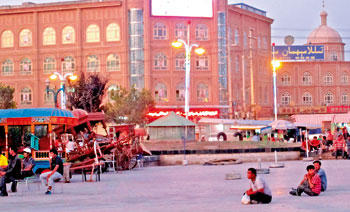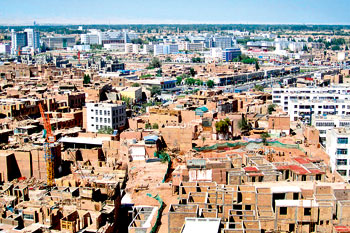KASHGAR, China, (AFP) - The call to prayer echoes across the old Silk Road city of Kashgar, drawing believers into the main mosque under the watchful eye of armed police, as building cranes loom in the distance.
It's the end of a day of fasting in this old trading post between East and West -- a remote city in China's far-western region of Xinjiang that is reeling from recent deadly attacks that laid bare long-standing ethnic tensions.
Undaunted, authorities are pressing ahead with plans to turn the restive city into a modern economic powerhouse -- to the dismay of many of the mainly Muslim Uighur minority, who fear it will have serious repercussions for them.
"This Kashgar is a new Kashgar, it's no longer an old city. Our culture has gone," lamented a 24-year-old Uighur shopkeeper who refused to be named because of the sensitivity of the issue.
The ancient, traditional Islamic part of the city is already in the throes of mass modernisation, as bulldozers tear down old mud-brick houses to replace them with look-alikes made of concrete and brick.
 |
| People outside a mosque in Kashgar, in northwest China's Xinjiang region. AFP |
China's communist government says the seven-billion-yuan ($1.1-billion) project aims to improve living standards for inhabitants of the old city, where it says many of the insalubrious houses would topple in an earthquake.
"Kashgar is located in a seismic zone so it's important that all houses are quake-safe. Our (new) houses can withstand an 8.0-magnitude earthquake," said Aysajan Ahat, an official in charge of the project.
But Uighurs who live there point out the old buildings have stood steadfast for hundreds of years and that they have little control over the design of their new homes.
Authorities deny this, saying residents are consulted every step of the way.
Ahat also insists that all demolished houses are being replaced, but residents say the old city is much smaller than it was.
"The programme of demolition and rebuilding is so messy that it is impossible to say whether all houses demolished are being replaced," said Michael Dillon, the Britain-based author of the book "Xinjiang, China's Muslim Far Northwest".
Elsewhere in the city, high-rises are springing up everywhere. A scale model of what planners want the city to look like -- on display at an exhibition -- shows the old town surrounded by a sea of modern tower blocks.
The government last year designated Kashgar a special economic zone, keen to boost investment in a city that stands at the crossroads of central and southern Asia.
It wants to push the city's annual GDP growth rate, which already exceeds 20 percent, to 25 percent over the next nine years, and plans to increase the population from the current 600,000 to a million by 2030.
Already migrants from other parts of China -- many of them members of the majority Han ethnic group -- have moved to Kashgar, lured by the prospect of making money in the fast-growing city.
Wu Shushuang, a 26-year-old who sells steel products, is originally from the eastern province of Anhui but ended up in Kashgar this year after making his way west from Shanghai.
"I make 20,000 yuan a month here compared to just 2,000 yuan before," he said.
But this influx has fuelled resentment among Xinjiang's roughly eight million Uighurs, many of whom complain that Han Chinese get better jobs and pay and say that traditional Uighur culture is being deliberately diluted.
"Some Uighurs go to university, they graduate, come back and can't find jobs. These all go to the Han. And even when they do find jobs, their salaries are low," one Uighur man said, in comments echoed by others interviewed by AFP.
This resentment has spilled over into bloody violence almost always directed at Han Chinese or security forces.
In July 2009, mobs of Uighurs attacked Han in Xinjiang's capital Urumqi, killing nearly 200 people and leaving 1,700 injured -- an incident that led to retaliatory attacks by Han on Uighurs several days later.
And on the weekend of July 30-31 this year, ethnic tensions once again burst to the fore when 13 civilians were killed in two knife attacks in Kashgar, which is about 90 minutes' flying time from the regional capital.
 |
| The old city of Kashgar, in northwest China's Xinjiang region. |
The Chinese government blames much of the violence in Xinjiang on separatist forces, but some experts say there is little evidence that organised terrorist groups operate in the region, adding unrest stems from economic frustrations.
"Some of my colleagues have left Kashgar (since the weekend violence) but I won't choose to leave, I have confidence in the government," said Wu.
Dillon said the violence would discourage Western firms.
"However, a lot of investment in Kashgar is from other parts of China and this is government-sponsored and will still go ahead. Investment from other parts of Central Asia is also a possibility," he said.
Dillon added that the government urgently needs to find a way to integrate Uighurs into the modern economy.
Many Uighurs do not speak Mandarin, China's official language, and have low levels of education. |



